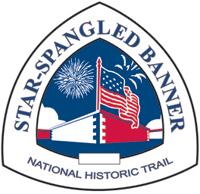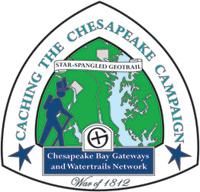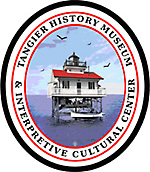During the first challenge along the Star-Spangled Banner GeoTrail, over 400 first edition SSB geocoins were awarded. We would like to thank everyone who participated in the Star-Spangled Banner GeoTour. We are currently out of geocoins but stay tuned for other opportunities along the Star-Spangled Banner GeoTour!


THIS CACHE IS NOW A TRADITIONAL HIDE located at: N37 49.560 W75 59.498. Thanks to Great Scott for helping with this hide!
Special Note: The terrain rating is for the hide once you arrive on the island. This location can only be reached via boat or airplane. Advance planning is highly recommended.
Come on a journey to remember and commemorate the dramatic chain of events, people and places that led to the birth of our National Anthem.
The story of the Star-Spangled Banner was shaped by the events of the Chesapeake Campaign during the War of 1812. From February 1813 until February 1815, the Chesapeake Bay was the center of a fierce struggle between the British and Americans. Places and landscapes still exist today that provide a touchstone to the past. The trail traces events and related sites that figured prominently in the Chesapeake Campaign of the War of 1812 that have national significance, physical integrity, and the potential for contemporary recreation and interpretation.

Special Note: The terrain rating is for the hide once you arrive on the island. This location can only be reached via boat or airplane. Advance planning is highly recommended. For complete transportation details, visit the Tangier Island website.
However, year-round ferries are available:
Two ferries run year round from Tangier, VA to Crisfield, MD
Courtney Thomas – Monday through Saturday 757-891-2240
Departs Tangier: 8:00 am Arrives Crisfield: 8:45 am
Departs Crisfield: 12:30 pm Arrives Tangier: 1:15 pm
Sharon Kay II – M & S Charters 757-891-2440
Mon-Fri: Departs Tangier: 4:00 pm Arrives Crisfield: 4:45 pm
Departs Crisfield: 5:00 pm Arrives Tangier: 5:45 pm
Sat-Sun: Departs Tangier: 3:00 pm Arrives Crisfield: 3:45 pm
Departs Crisfield: 4:00 pm Arrives Tangier: 4:45 pm
We welcome all to come and learn about the history of Tangier and its people and to aid in their interpretation. THMICC has a museum/visitors center, a walking history trail, a nature trail and water trails with free use of kayaks and canoes.
9/30/12: This is now a traditional hide and not a mutli. I will leave these cords as reference points for future visitors.
Visit to Tangier Island at the city dock: N37 49.695 W075 59.484
Be sure to visit the Tangier Island History Museum located at N37 49.560 W075 59.515 (16215 Main Ridge Road). The museum is a must-see during your visit and is open from 11AM-4PM and on request. Please visit www.tangierhistorymuseum.org or call (302) 234-1660 for more information.

Given its central location in the Bay, it is not surprising that Tangier Island enjoyed strategic importance for British forces during the War of 1812. Easy to defend due to the shallows and surrounding islands, Tangier offered the Royal Navy easy access to the Potomac River, the Patuxent River and the central and upper portions of the Bay. Christened by the British as "Fort Albion," the island was first occupied in a temporary fashion in April 1813. A year later, it was re-occupied in a more permanent manner, intended to serve as a long term base for thousands of men. At its peak, 12,000 British troops were present.
Fort Albion was located near the island's Camp Meeting Grove, where Rev. Joshua Thomas, a Methodist Minister responsible for bringing the faith to Tangier, frequently preached to the British officers and men. Legend holds that on the eve of their departure for the Battle of Baltimore, Thomas gave a powerful "Thou shall not kill" sermon and predicted the British would fail in their attempt to take the city. His prediction proved accurate, as the British failed in their attack.
It was also at Fort Albion that the British recruited hundreds of African men escaped from slavery into a force known as the "Colonial Marines.” As reported by historian Frank A. Cassell in his article “Slaves of the Chesapeake Bay Area and the War of 1812,” the new unit had its first combat experience in May 1814, when the British assaulted an American battery at Pungoteaque, Virginia. Under cover of rocket and cannon fire, royal marines and the black colonial marines attacked the American position. After a fierce contest, in which one of the black soldiers was killed and five wounded, the Americans surrendered. Captain James Ross, who commanded the expedition, was pleased with the performance of the black troops. "Their conduct," he wrote Cockburn, "was marked by great spirit and vivacity, and perfect obediance." Colonial Marines would also see combat along the Patuxent River in Maryland and as skirmishers before the Battle of Baltimore.
Tangier Island, located 12 miles west of Onancock, Virginia, is made up of many small islands divided by marshes and small tidal streams. It is possible to reach Tangier by boat, with trips departing from the eastern shore of both Maryland and Virginia and the Northern Neck of Virginia in Reedville. You can also reach Tangier by air, landing at its airstrip. See www.tangierhistorymuseum.org for more information. Tangier Island Museum and Cultural Interpretive Center is a living history center for the island and its residents. It serves as a wonderful starting point for experiencing Tangier on foot or by small water craft. The center offers free use of canoes and kayaks to paddle water trails and follow the route Captain John Smith did 400 years ago, through pristine marsh home to hundreds of birds and waterfowl. Inside the museum, you can learn about how residents have coped with challenges in the past, and continue to do so as the island is battered by erosion, winds and water, and the effects of pollution and increased regulations on the crab harvest.

Thanks to Corfmania for helping with this hide and to the Maryland Geocaching Society for assisting with this project!